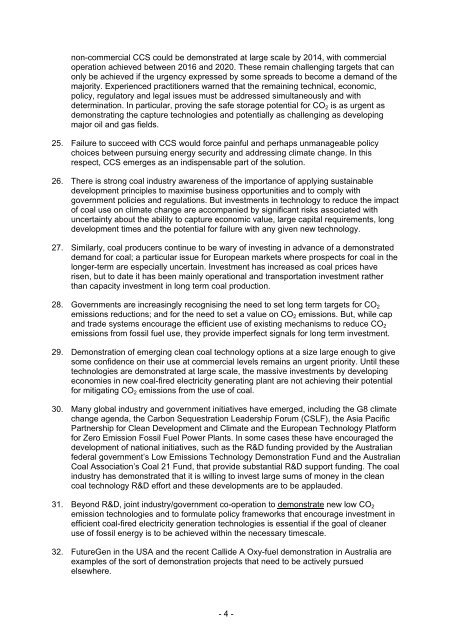CIAB Market & Policy developments 2005/06 - IEA
CIAB Market & Policy developments 2005/06 - IEA
CIAB Market & Policy developments 2005/06 - IEA
Create successful ePaper yourself
Turn your PDF publications into a flip-book with our unique Google optimized e-Paper software.
non-commercial CCS could be demonstrated at large scale by 2014, with commercial<br />
operation achieved between 2016 and 2020. These remain challenging targets that can<br />
only be achieved if the urgency expressed by some spreads to become a demand of the<br />
majority. Experienced practitioners warned that the remaining technical, economic,<br />
policy, regulatory and legal issues must be addressed simultaneously and with<br />
determination. In particular, proving the safe storage potential for CO 2 is as urgent as<br />
demonstrating the capture technologies and potentially as challenging as developing<br />
major oil and gas fields.<br />
25. Failure to succeed with CCS would force painful and perhaps unmanageable policy<br />
choices between pursuing energy security and addressing climate change. In this<br />
respect, CCS emerges as an indispensable part of the solution.<br />
26. There is strong coal industry awareness of the importance of applying sustainable<br />
development principles to maximise business opportunities and to comply with<br />
government policies and regulations. But investments in technology to reduce the impact<br />
of coal use on climate change are accompanied by significant risks associated with<br />
uncertainty about the ability to capture economic value, large capital requirements, long<br />
development times and the potential for failure with any given new technology.<br />
27. Similarly, coal producers continue to be wary of investing in advance of a demonstrated<br />
demand for coal; a particular issue for European markets where prospects for coal in the<br />
longer-term are especially uncertain. Investment has increased as coal prices have<br />
risen, but to date it has been mainly operational and transportation investment rather<br />
than capacity investment in long term coal production.<br />
28. Governments are increasingly recognising the need to set long term targets for CO 2<br />
emissions reductions; and for the need to set a value on CO 2 emissions. But, while cap<br />
and trade systems encourage the efficient use of existing mechanisms to reduce CO 2<br />
emissions from fossil fuel use, they provide imperfect signals for long term investment.<br />
29. Demonstration of emerging clean coal technology options at a size large enough to give<br />
some confidence on their use at commercial levels remains an urgent priority. Until these<br />
technologies are demonstrated at large scale, the massive investments by developing<br />
economies in new coal-fired electricity generating plant are not achieving their potential<br />
for mitigating CO 2 emissions from the use of coal.<br />
30. Many global industry and government initiatives have emerged, including the G8 climate<br />
change agenda, the Carbon Sequestration Leadership Forum (CSLF), the Asia Pacific<br />
Partnership for Clean Development and Climate and the European Technology Platform<br />
for Zero Emission Fossil Fuel Power Plants. In some cases these have encouraged the<br />
development of national initiatives, such as the R&D funding provided by the Australian<br />
federal government’s Low Emissions Technology Demonstration Fund and the Australian<br />
Coal Association’s Coal 21 Fund, that provide substantial R&D support funding. The coal<br />
industry has demonstrated that it is willing to invest large sums of money in the clean<br />
coal technology R&D effort and these <strong>developments</strong> are to be applauded.<br />
31. Beyond R&D, joint industry/government co-operation to demonstrate new low CO 2<br />
emission technologies and to formulate policy frameworks that encourage investment in<br />
efficient coal-fired electricity generation technologies is essential if the goal of cleaner<br />
use of fossil energy is to be achieved within the necessary timescale.<br />
32. FutureGen in the USA and the recent Callide A Oxy-fuel demonstration in Australia are<br />
examples of the sort of demonstration projects that need to be actively pursued<br />
elsewhere.<br />
- 4 -
















